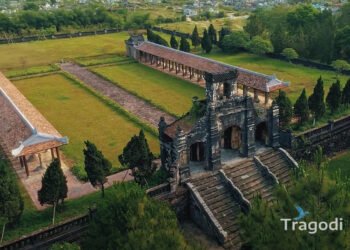
People of Hue
The people of Hue are characterized by their steadfastness, patriotism, scholarly nature, sophistication, humility, and closeness to nature. They are people who know how to preserve and promote the cultural values of their ancestors, while absorbing and creating new cultural values. The people of Hue also know how to live harmoniously, united, and friendly with everyone. They have a special love for the Perfume River, Ngu Mountain, palaces, temples, and other beautiful aspects of Hue.
History of Hue
The history of Hue began in the 13th century when this land was called Thuan Hoa, part of Chan Lap prefecture of the Tran dynasty. Later, this land became the military base of the Ho, Early Le, and Mac dynasties.
In 1558, Nguyen Hoang, son-in-law of King Mac Dang Dung, was appointed as the lord of Thuan Hoa, marking the beginning of the Nguyen dynasty.
In 1687, Lord Nguyen Phuc Tan moved the capital from Kim Long to Phu Xuan, now Hue city, and built many palace architectural works.
In 1802, King Gia Long unified the country and named it Dai Nam, with the capital in Hue. From then on, Hue became the capital of the three Nguyen dynasties, until 1945, when King Bao Dai abdicated and transferred power to the Democratic Republic of Vietnam government.
During its time as the capital, Hue witnessed many important historical events, such as the Tay Son uprising, the Franco-Dai Nam war, the Can Vuong uprising, the Indochina war, the Vietnam war, the Tet Offensive…
Hue is also associated with many famous historical figures such as King Quang Trung, King Minh Mang, King Tu Duc, King Duy Tan, King Khai Dinh, and King Bao Dai…
Culture of Hue
The culture of Hue is the crystallization of many tangible and intangible cultural elements, through many successive historical periods. Hue culture is influenced by royal culture, folk culture, urban culture, Buddhist culture, Catholic culture, French culture, Chinese culture… Hue culture is most clearly expressed in fields such as architecture, music, art, festivals, cuisine, costumes, language, religion, customs, traditions…
In the field of architecture, Hue stands out with its royal architectural works, such as the Imperial City, the Forbidden Purple City, the mausoleums, the temples, the military facilities… These works were built in the traditional Vietnamese architectural style, combined with elements of French, Chinese, Japanese architecture… These works not only have architectural value, but are also symbols of the power, dignity, intelligence, and artistry of the Nguyen kings.
In the field of music and art, Hue is famous for its royal court music, court dances, Hue songs, Tuong art, fine arts, and crafts:
- Royal court music is a type of music performed on royal ceremonial occasions, including ceremonial music, literary music, martial music, and palace music. Royal court music was recognized as a Representative Intangible Cultural Heritage of Humanity by UNESCO in 2003.
- Court dances are a type of dance performed on royal ceremonial occasions, including ceremonial dances, literary dances, martial dances, and palace dances. Court dances have many graceful and sophisticated movements, expressing reverence, respect, and harmony.
- Hue songs are a type of folk music, sung on the Perfume River, with melodious and romantic tunes, expressing the feelings and emotions of the people of Hue.
- Tuong art is a traditional stage art, performed on the royal court stage or folk stage, with many types such as royal Tuong, popular Tuong, teacher Tuong, continuous Tuong, sutra Tuong…
- Fine arts and crafts of Hue are the crystallization of many tangible cultural elements, through many successive historical periods. Fine arts and crafts of Hue are most clearly expressed in fields such as sculpture, lacquer, ceramics, glassware, embroidery, paper crafts…
Hue is a unique city that preserves and develops traditional cultural values while absorbing and creating modern cultural values. The city has witnessed many important historical events and contributed many famous historical figures, literature, and art of Vietnam. Hue has many architectural works with unique and diverse cultural backgrounds. The people of Hue are sophisticated, humble, and friendly. Come to Huế to experience the beauty of a city rich in tradition and modernity .










